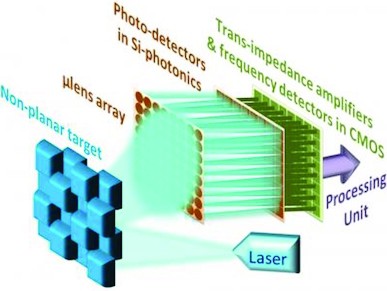The new system, developed by researchers at the University of California, Berkeley, can remotely sense objects 10 times farther than what could be done with comparable current low-power laser systems.
With further development, the technology could be used to make smaller, cheaper 3D imaging systems that offer exceptional range for potential use in self-driving cars, smartphones and interactive video games, all without the need for big, bulky boxes of electronics or optics.

‘While meter-level operating distance is adequate for many traditional metrology instruments, the sweet spot for emerging consumer and robotics applications is around 10 meters’ or just over 30 feet, said UC Berkeley’s Behnam Behroozpour, who will present the team’s work at CLEO: 2014, being held June 8-13 in San Jose, California. ‘This range covers the size of typical living spaces while avoiding excessive power dissipation and possible eye safety concerns.’
According to The Optical Society, the new system relies on LIDAR (light radar), a 3D imaging technology that uses light to provide feedback about the world around it. LIDAR systems of this type emit laser light that hits an object, and then can tell how far away that object is by measuring changes in the light frequency that is reflected back. It can be used to help self-driving cars avoid obstacles, or to help video games tell when players are jumping, pumping their fists or swinging a ‘racket’ at an imaginary tennis ball across an imaginary court.
In contrast, current lasers used in high-resolution LIDAR imaging can be large, power-hungry and expensive. Gaming systems require big, bulky boxes of equipment, and players have to stand within a few feet of the system for them to work properly, Behroozpour said in a statement. Bulkiness is also a problem for driverless cars such as Google’s, which must carry a large 3D camera on its roof.
The researchers sought to shrink the size and power consumption of the LIDAR systems without compromising their performance in terms of distance.
In their new system, the team used frequency-modulated continuous-wave (FMCW) LIDAR, which they felt would ensure their imager had good resolution with lower power consumption, Behroozpour said. This type of system emits so-called frequency-chirped laser light (whose frequency is either increasing or decreasing) on an object and then measures changes in the light frequency that is reflected back.
To avoid the drawbacks of size, power and cost, the Berkeley team exploited MEMS tuneable VCSELs. MEMS (micro-electrical-mechanical system) helped to change the frequency of the laser light for the chirping, while VCSELs (vertical-cavity surface-emitting lasers) are a type of inexpensive integrable semiconductor lasers with low power consumption. By using the MEMS device at its resonance the researchers were able to amplify the system’s signal without a great expense of power.
‘Generally, increasing the signal amplitude results in increased power dissipation,’ Behroozpour said. ‘Our solution avoids this trade-off, thereby retaining the low power advantage of VCSELs for this application.’




Project to investigate hybrid approach to titanium manufacturing
What is this a hybrid of? Superplastic forming tends to be performed slowly as otherwise the behaviour is the hot creep that typifies hot...